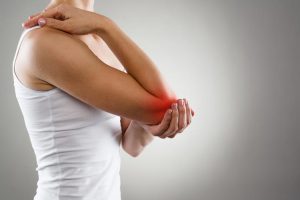This post is also available in:
Tiếng Việt (Vietnamese)

Definition
What is bursitis?
Bursitis is an inflammation (swelling, redness) of a bag filled with liquid known as synovium. Synovium is usually located around the shoulders, elbows, hips, knees, feet.
Synovium which acts as a cushion between the bones and surrounding organs such as muscles, tendons, skin, since it enables one to move more easily.Bursitis often occurs in the joints to move frequently. The disease tends to recur after treatment, unless the cause is stopped.
How common is bursitis?
All of them may have bursitis. However, the older the risk will be higher, especially in people who do the work must be repeated many times an activity, such as painters, gardeners, musicians.
Symptoms
What are the symptoms of bursitis?
Symptoms of bursitis are quite simple and easy to recognize. These include:
- Feeling soreness or stiffness.
- Swelling and redness.
- The pain is usually worse when you move or click.
When should I see my doctor?
Bursitis but not a serious disease but if not treated properly can become severe. You should contact your doctor right away if:
- The pain lasts more than 1 week without reduction.
- Swelling too much, redness, bruising or rash affected area.
- Sudden sharp pain, especially while exercising.
- Having fever.
Causes
What causes bursitis?
Overuse and direct trauma in joints are common causes leading to bursitis. The joint injury can happen when you play sports, when lifting heavy objects, or the work must operate more limbs (like scrubbing floors). Also, diseases such as rheumatoid arthritis, gout, thyroid disease, and diabetes can also cause bursitis.
Risk factors
What increases my risk for bursitis?
The following factors may make you more prone to bursitis than:
- Age: the older you are the higher your risk.
- Occupation and hobbies: risk of bursitis will increase if the profession or hobby requires repetitive movements monotonous and putting pressure on a certain in synovium. For example, painters, gardeners, musicians.
- Some diseases such as rheumatoid arthritis, gout and diabetes may increase the risk of bursitis.
There are no risk factors does not mean you cannot get sick. These factors are for reference only. You should consult a specialist doctor for more details.
Diagnosis & treatment
The information provided is not a substitute for any medical advice. ALWAYS consult with your doctor for more information.
How is bursitis diagnosed?
Some treatments bursitis usually include:
- Rest, stop the operation for at least 2 weeks. Fixed with a splint or cast for 7-10 days.
- Put ice on the sore area to reduce swelling and relieve pain.
- Use anti-inflammatory drugs such as aspirin, ibuprofen, naproxen can be effective against bursitis mild to moderate.
- If bursitis caused by an infection, the doctor may prescribe an antibiotic for you.
- Aspiration, or withdrawal of services in the synovium, can help relieve pain and help doctors temporary fluid examination to check you have an infection or not gout. However the disease can still relapse, further aspiration too much will increase the risk of infection and tendon rupture.
If the disease remains in remission after 6-12 weeks of treatment. Your doctor may require arthroscopic or open surgery to repair damage and relieve pressure on the synovial pocket.
A physical therapist, occupational therapist or athletic trainer can help you in the reorganization of activities in life to minimize the impact of bursitis.
How is bursitis treated?
Doctors diagnosed bursitis based on clinical history and examination. The doctor may also ask to make some diagnostic methods below:
- X-rays to help rule out other causes of the symptoms, such as fractures.
- Ultrasound or MRI may be indicated if the bursitis can not be diagnosed through clinical examination.
- Tests of blood or fluid obtained from tests where the infection to cause bursitis.
Read more post:
Lifestyle changes & home remedies
What are some lifestyle changes or home remedies that can help me manage bursitis?
The following lifestyles and home remedies might help you cope with Bursitis:
- Relax and do not move the inflammation to speed recovery.
- Apply ice to reduce swelling.
- If you suffer from bursitis in the knee, put a pillow between the legs while lying on your side to reduce pressure on the knee.
- If you suffer from bursitis in the elbow, avoid pressing on hand when reclining.
- Wear protective gear when playing sports antagonists.
- Avoid repetitive activities.
If you have any questions, please consult with your doctor to better understand the best solution for you.
Sources:
- Porter, R. S., Kaplan, J. L., Homeier, B. P., & Albert, R. K. (2009). The Merck manual home
health handbook. Whitehouse Station, NJ, Merck Research Laboratories.
- Questions and Answers About Bursitis and Tendinitis. http://www.niams.nih.gov/Health_Info/Bursitis/default.asp#6. Accessed September 15, 2016.
- Bursitis Risk Factors. http://www.mayoclinic.org/diseases-conditions/bursitis/basics/risk-
factors/con-20015102. Accessed September 15, 2016.
- Review Date: February 3, 2017 | Last Modified: February 3, 2017

